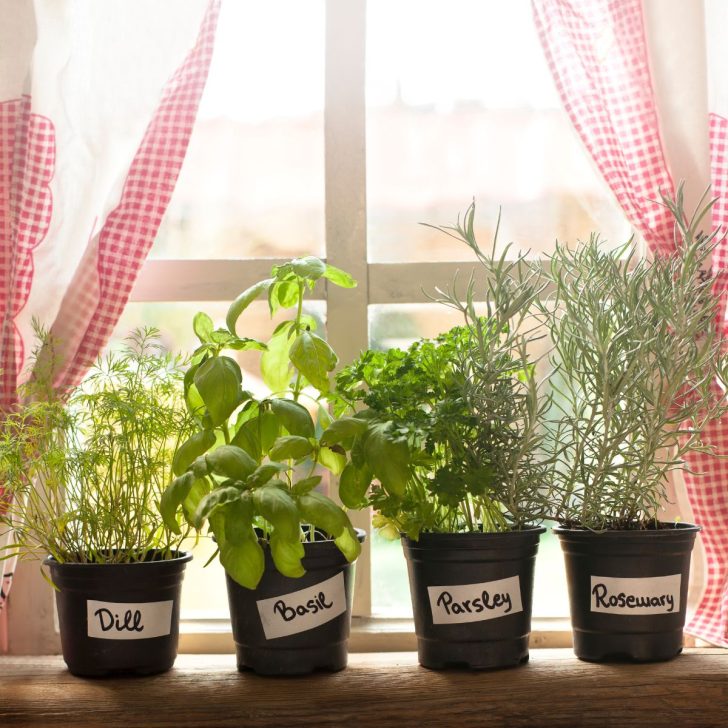With the onset of cold weather, if you get the winter doldrums and miss growing things in the garden, it may be time to start thinking about the best herbs to grow indoors in winter.
Or perhaps you don’t have a garden, but want to grow herbs in pots year round…?
Growing herbs indoors is one way to keep your kitchen stocked with fresh herbs all year long. More than fresh flavors for food and tea, with herbs you have medicinally potent seasonings that pack a nutritional punch.
You can also grow and use healing herbs for cold and flu as well as immunity, herbs for stress, and antifungal herbs.
But with so many options out there, it can be tough to know where to start. Which are the best herbs to grow indoors in pots year round?
In this article, we cover our top picks for the best herbs to grow indoors in winter and year round, and why we chose them, and how to keep them happy indoors.
Equipment Needed for Growing Herbs Indoors
- Good organic potting soil that drains well
- 9-12″ pots or planters with good drainage holes
- Herb seeds or seedlings
- Grow Lights (such as these best LED grow lights)
- Fertilizer – once/year
With the right equipment, you can grow any herb indoors in winter or year-round. Below, we’ll get into some of the very best herbs to grow with and without artificial lighting. Add one nine to twelve inch pot for each herb plant and you’re off to a good start. Next, we add herbs – seeds or seedlings!
HERB FERTILIZER: A 5-10-5 fertilizer applied once in late spring should be enough for most herbs.
SOURCE: The University of Michigan[1]https://extension.umn.edu/vegetables/growing-dill-home-gardens

11 BEST HERBS TO GROW INDOORS
Here are our picks for the best herbs to grow indoors year round, or just in the winter. We’d love to hear about yours! Feel free to send plant pictures too!
When it comes to pruning, clippings of herbs to put to use in cooking, salads and tea is the best way to keep the plants pruned and producing new growth. Other than that, some will need the occasional pruning away of scraggly branches and leaves.
These herbs can be grown without a grow light so long as they get at least a half day of direct sunlight from a sunny window. However, most herbs will perform best in a southern facing window and/or supplemented with grow lights.
Indoor plants need approximately twice the amount of grow light time as sunlight requirement.
Most indoor herbs do best in a sunny window.

Herbs to Grow Indoors
NOTE: In the outlines of plants below, whenever there’s just one number rather than a range relative to the plant needs, it’s the average of the ideal range, so you can adjust upward and downward accordingly. E.g., instead of 50°-70°, for instance, our average would post as ~60°F.
Basil (Ocimum basilicum)
An attractive and aromatic indoor plant, basil is one of the most popular herbs to grow indoors and out, and for good reason. Basil isn’t fussy, and its fragrant leaves add a fresh sweet scent to your home and imbue your food with its uniquely pungent sweetness favored in salads, soups, pizza, pastas, pesto and Italian herb butter.
This annual herb enjoys an average 7 hours of sun each day and prefers a loamy soil that drains quickly. Whether you’re growing indoors or outside, harvest the leaves regularly to stimulate regrowth.
- USDA Hardiness Zone (if kept outside): 3-9
- Light Needs: ~7 hours sunlight or 14 hours grow light; can tolerate some shade
- Soil Type: Well-drained sandy, loamy soil
- Type: Annual in zones 9 and below; perennial in tropical zones
- Humidity Average : ~50%.
- Temperature Average: ~60°F / 15°C
- Pruning: prune unhealthy stems; snip for use regularly
Sweet basil thrives as an annual in zones 3-9; zones 10 and up enjoy it as a perennial.

Chives (Allium schoenoprasum)
Chives are a pleasant addition to your garden, providing delicate mild onion-flavored flowers and leaves with a hint of garlic.
The hardy perennial does best with ample amounts of full sun and damp soil. When established, chives are quite low maintenance and will often last for several years without needing more than basic care. Though the plants tolerate drought, it’s best only to let them dry out slightly between waterings.
When flowers begin to form, cutting the entire plant back by two to three inches can help promote new growth and keep leaves from becoming too tough or stringy. Finally, dividing the clumps every few years will ensure lush foliage and prevent overcrowding in the garden bed or indoor pot.
- USDA Hardiness Zone (if kept outside): 3-9
- Light Needs: ~7 hours sunlight or 14 hours grow light; can tolerate some shade
- Soil Type: Well-drained sandy, loamy soil that is acidic to neutral in pH
- Type: Perennial
- Humidity Needs: 40%
- Pruning: Clip for use and to encourage growth; prune unhealthy sections
See more on how to grow chives.
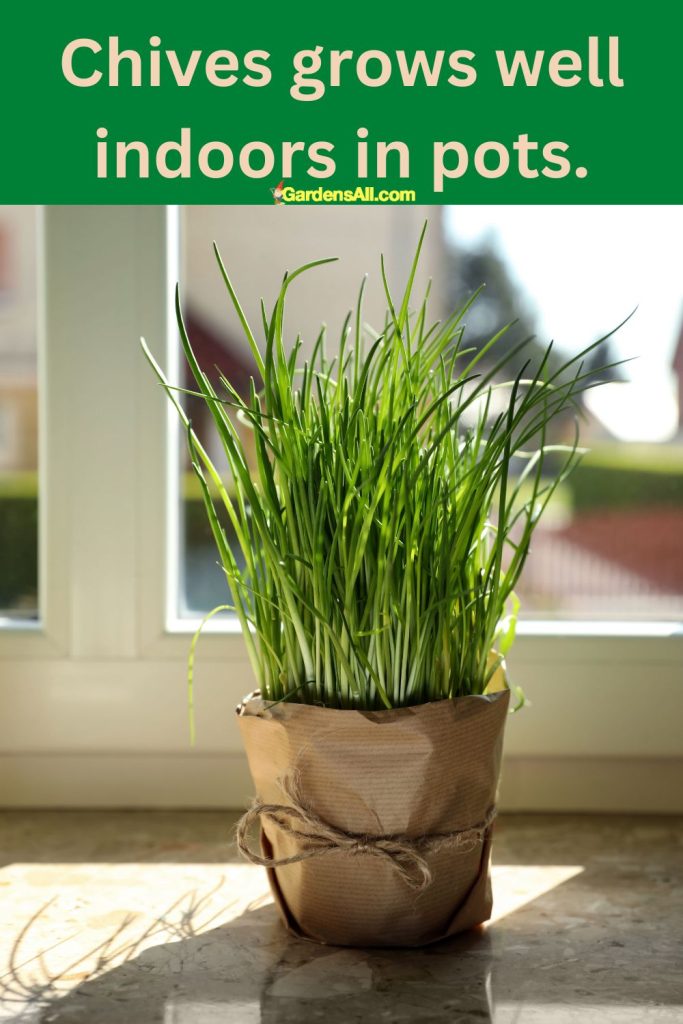
Dill – (Anethum graveolens)
A tender annual, dill is related to carrots, cilantro and parsley, with similar lacy foliage to it’s relatives in the Apiaceae family.
A native of Asia Minor and the Mediterranean region, the seeds and leaves of the tall leggy plant is popular for pickling. Dill foliage and seeds are also used in soups, salads, breads, party dips and fish dishes.
- USDA Hardiness Zone (outdoors): 3-7
- Light Needs: ~7 hours sunlight or 14 hours grow light; can tolerate some shade
- Soil Type: Well-drained, slightly acidic,
- Type: Annual in zones 3-7; perennial in zones 9b-11
- Humidity Needs: Average
- Pruning: Clip for use and to encourage growth; prune unhealthy sections

French Tarragon (Estragon)
French tarragon is another excellent herb to grow indoors year-round and adds an interesting flavor profile to many dishes. The leaves of this herb are known for their mild licorice flavor and are often used in salads, sauces, or garnish.
French tarragon prefers full sun but can tolerate partial shade as well; a south-facing window where it can “see” the sun is best. At the bare minimum, it should be able to “see” the sky from where it sits.
This herb, which is related to sunflowers, requires little maintenance and should be watered once or twice per week depending on its location, the container type, and your home’s humidity.
- USDA Hardiness Zone (if kept outside): 4-9
- Light Needs: ~5 hours of sun at 50/50 sunlight to partial shade, (doesn’t like it too hot), or ~10 hours grow light
- Soil Type: Well-drained sandy soil that is neutral in pH
- Type: Perennial
- Humidity Needs: medium to low humidity
- Pruning: prune to prevent bolting, which causes an undesirable bitter flavor

Lavender (Lavendula spp.)
Lavender is one of the most fragrant compact shrubby herbs you can grow indoors year-round. Its beautiful purple flowers add color, texture, beauty, and pleasant smells to your home and great flavor to your dishes. Use it in your cooking, or turn it into an essential oil for perfumes, candles, soaps, bug sprays, and more.
Lavender loves sunshine and needs a lot of good drainage. Plant it in containers with sandy-mixed soil specifically designed soil for growing lavender or a cacti/succulent soil. This plant technically does not need a grow light in you have it on a bright, south-facing windowsill, but it will benefit from one if you have one.
- USDA Hardiness Zone (outside): 5a-9a
- Light Needs: Full sun, or 16 hours grow light
- Soil Type: Well-drained, dry, sandy soil that is alkaline in pH, such as cactus soil
- Type: Perennial
- Humidity Needs: 20 to 35%; will mold and wither if too humid
- Pruning: clip for use; prune annually to prolong life and remove woodiness that can later split and break
See also, growing lavender.
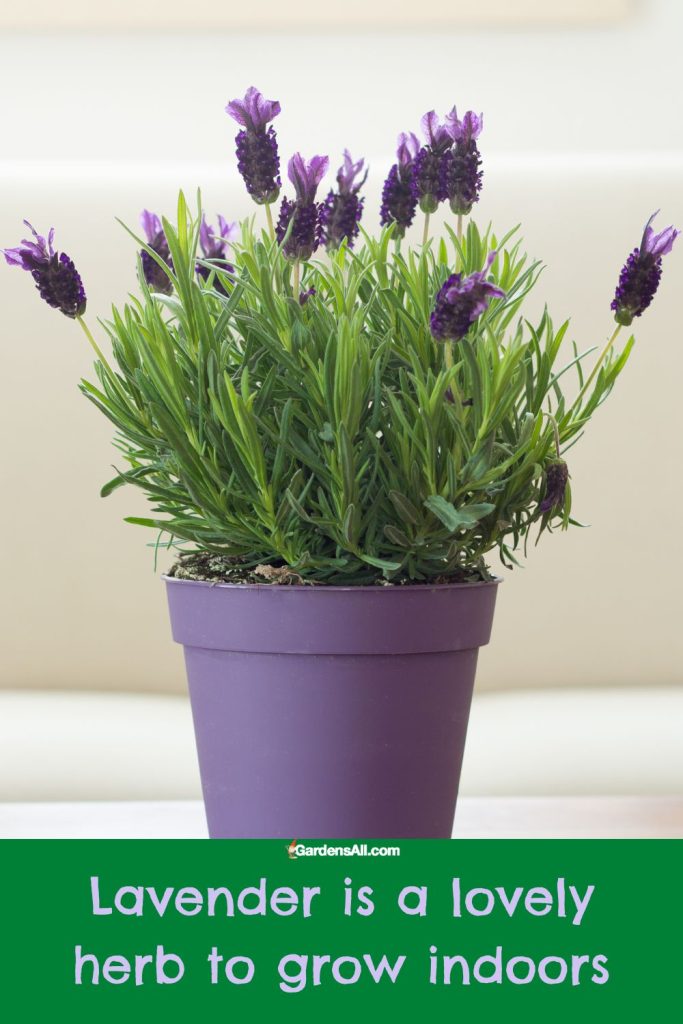
Lemon Balm – (Melissa officinalis)
Lemon balm may be the perfect indoor herb for winter because it has a wonderful citrus scent and flavor to keep your spirits up through the cold and dark months. Since it is part of the mint family, it’s easy to please and will grow impressively fast.
It does best in a south-facing window where it won’t be exposed to any drafts. Eastern and western exposure are the next best options.
When Lemon Balm reaches maturity, it blooms refreshingly fragrant cute white to pale yellow flowers. If planted outdoors, it reaches three feet wide, and up to two feet tall; in a small indoor container, it will be naturally be much smaller and more manageable.
- USDA Hardiness Zone (outside): 3-7
- Light Needs: ~5 hours direct light or 10 hours grow light
- Soil Type: Well-drained, moist soil that is acidic to neutral in pH
- Type: Perennial
- Humidity Needs: Low to medium preferred
- Pruning: prune or pinch for improved airflow and to encourage new growth
You may also enjoy reading this article on growing lemon balm.

Mint – (Mentha)
While lemon balm is also a mint, there are many others in the mint family that are popular herbs for indoor gardens because it’s easy to cultivate and does not require much maintenance. Mint leaves can be used fresh or dried for teas, salads, ice creams, sauces, jellies, and more!
Mint prefers full sun but will also do well with partial shade if it gets plenty of water throughout the growing season. If put outdoors, it will reach two to three feet tall and will spread outwards as much as you allow. The blooms are lavender, fuzzy, and sweet-smelling.
Mint is often favored for containers outdoors as well to contain the proclivity to take over the garden. So if you plan to transplant yours come spring, you may want to keep growing it in containers.
- USDA Hardiness Zone (if kept outside): 4-10
- Light Needs: Full sun to partial shade, or 10 hours grow light
- Soil Type: Well-drained, rich and moist soil that is neutral in pH
- Type: Perennial
- Humidity Needs: 45%
- Pruning: regularly prune to prevent flowering and encourage more leaves to come in

Parsley – (Petroselinum crispum)
This lacey foliage herb is perfect for east or west-facing windows in your home. It’s great as a garnish, condiment, flavor, or used as an essential oil. Be aware that parsley should be used in limited quantities because it is technically toxic for humans and animals.
Parsley is available in two categories, curly and ornamental (Petroselinum crispum) and flat-leafed culinary uses (P. crispum neapolitanum). All parsley is refreshing with an herbal sweetness, with the curly parsley being a little strong in flavor than the flat-leafed parsley, which has less of the bitter nuance.
- USDA Hardiness Zone (if kept outside): 2-11
- Sun Needs: Full sun to partial shade, or 10 hours of grow light
- Soil Type: Well-drained, moist, loamy soil that is acidic to neutral in pH
- Type: Biennial
- Humidity Needs: Average
- Pruning: Clip for use and to encourage growth; prune unhealthy sections
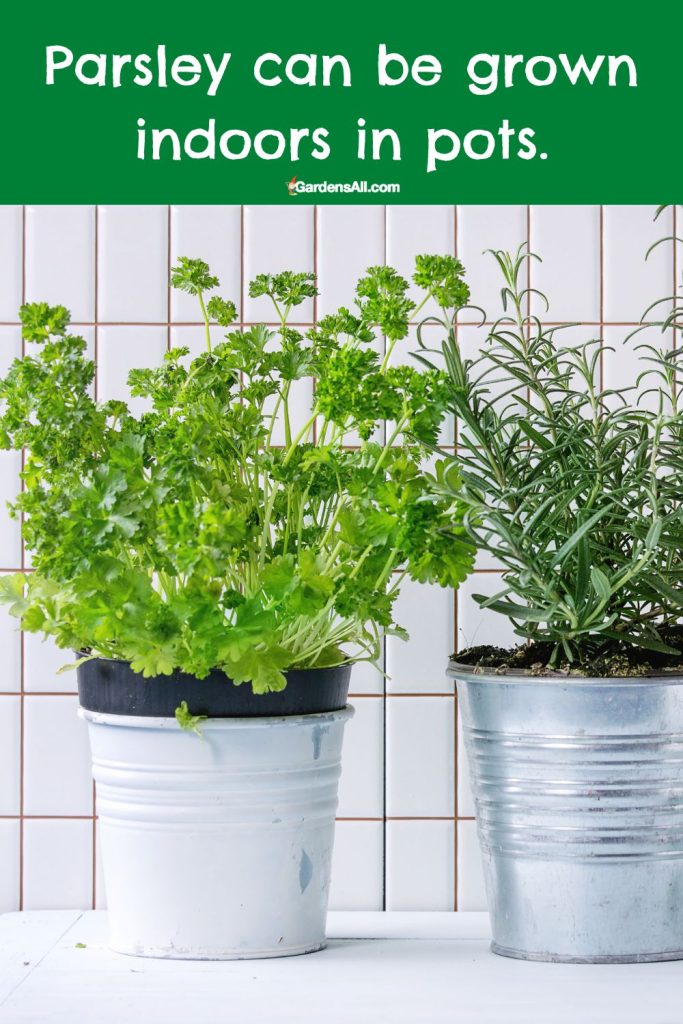
Rosemary (Salvia Rosmarinus)
This lovely fragrant herb is a perennial evergreen plant that produces lovely small flowers that are white to light blue in hue.
Left unchecked, Rosemary can grow to be four feet wide and six feet tall– but no worries, in a container, it will be small and manageable.
Since this plant needs so much light, it’s best to keep it under an artificial growing light for fourteen to twenty hours a day.
- USDA Hardiness Zone (outside): 7-10
- Sunlight Needs: Full sun (8-14 hours); grow light ~16 hours
- Soil Type: Well-drained sandy, loamy soil that is acidic to neutral in pH
- Type: Perennial in zones 7-10
- Humidity Needs: 45 to 55%
- Pruning: Clip for use and to encourage growth; prune unhealthy sections

Sage – (Salvia officinalis)
Few meals warm the soul quite like a roasted turkey with sage stuffing in the midst of winter. It has a distinct peppery yet earthy flavor. It’s somewhat shrubby, with soft and wooly leaves that are a beautiful gray-green (sage) color. The growth rate is moderate.
Use the leaves fresh, dried, or freeze-dried.
Sage can grow indoors without any artificial light, but it’s on the cusp, which is why we recommend using a grow light if that’s possible. Growing your own indoor sage is simple, rewarding, and smells so pleasant.
- USDA Hardiness Zone (outside): 4-10
- Light Needs: Full sunlight (8-14 hours) or up to 16 hours grow light
- Soil Type: Sharp-drained sandy, poor (little to no fertilizer) soil that is acidic to neutral in pH
- Type: Perennial
- Humidity Needs: Low up to 40%
- Pruning: annually, when the tallest shoots turn woody; clipping branches as needed for use
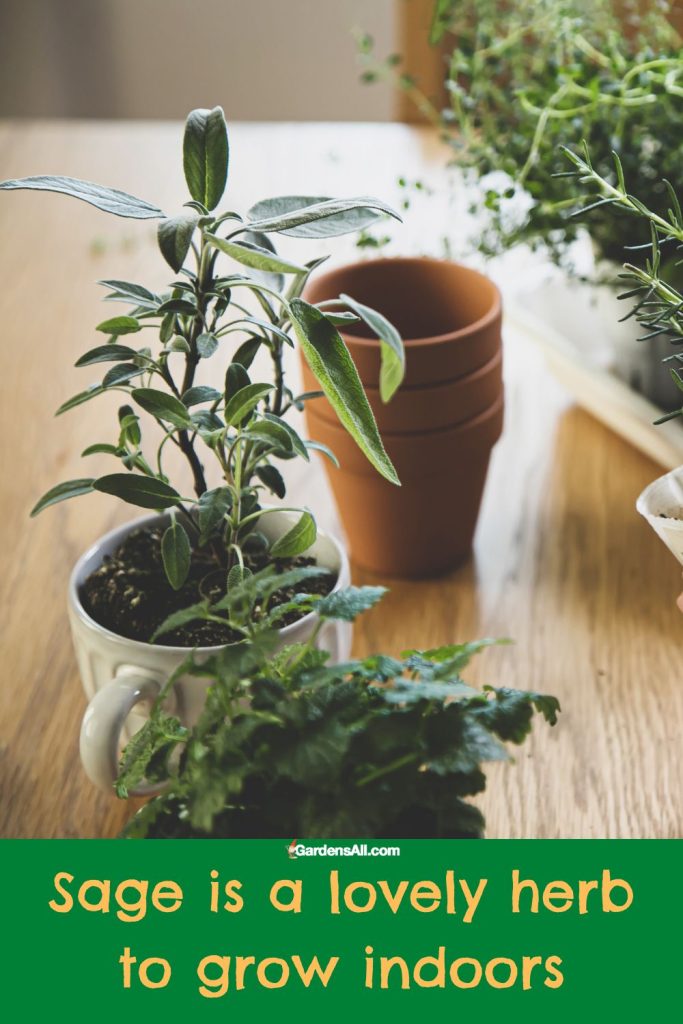
Thyme (Thymus vulgaris)
Fresh thyme leaves add a unique flavor profile to many savory dishes such as soups, stews, sauces, and more. It’s a popular herb to season a variety of meats.
Thyme is a versatile herb that grows best in sunny areas with plenty of airflow, but it still tolerates some shade during the winter months as long as adequate drainage is present. This herb requires regular watering throughout its growing season but should also be pruned occasionally to prevent overgrowth and keep it healthy! If not pruned, it can grow to be six to twelve inches tall and wide.
It’s best practice to keep thyme in lower humidity areas, so kitchens and bathrooms are generally off-limits. Terrariums are not ideal for this herb either.
It may grow well on a windowsill, but an added artificial light will serve you and the plant better, if possible.
- USDA Hardiness Zone (if kept outside): 5-9
- Sun Needs: Full light (8-14 hours), or 14-16 hours grow light
- Soil Type: Well-drained sandy, loamy soil that is acidic to alkaline in pH
- Type: Perennial
- Humidity Needs: 30-40%
- Pruning: Prune after it has flowered to encourage new growth
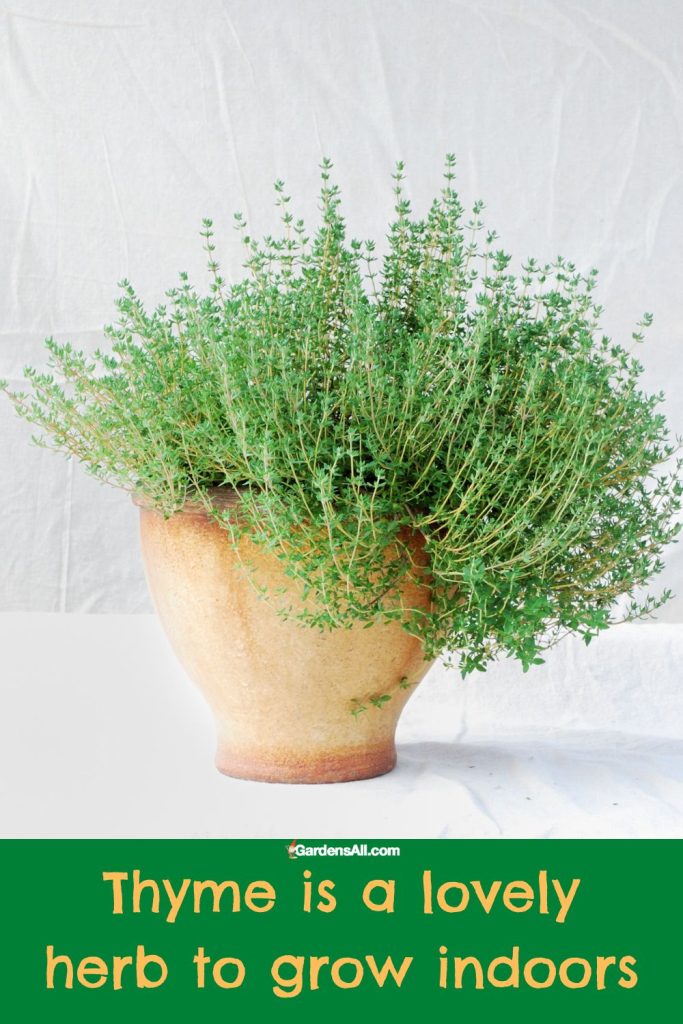
Artificial Light Needed for Flowering and Fruiting Herbs and Vegetables
Wondering how much light herbs need to grow indoors? While that naturally varies from plant to plant, below is a brief guideline according to the University of New Hampshire extension field specialist, Jonathan Ebba.
Full Sun vs. Artificial Light Needs of Herbs
For more information on growing lights and indoor plants, refer to this handy fact sheet from Purdue University.
- Shade plants need 6-8 hours of artificial light per day.
- Partial shade plants need 10-12 hours of a grow light daily.
- Full sunshine plants need 14-16 hours of artificial light a day.
For plants that are still in the seedling stage, the maximum exposure should be limited to eight to twelve hours at the most. Many plants need a set number of dark hours to recover and prepare for the next day.
LED shop lights will work for plants, and your artificial light source does not always have to be labeled as grow lights. It’s more important to get the intensity and duration right than it is to be perfect with your quality (spectrum).
So do grow lights work for herbs? Yes! You just have to learn to use them correctly. Here’s our list of the best LED grow lights to use for your indoor herb garden.
What Herbs Can Grow Indoors in Low Light?
The following seven herbs can all grow adequately in low light:
- basil
- chives
- French tarragon
- lavender
- lemon balm
- mint
- parsley
More sunshine is always preferred, but they will survive low light if needed. Where this comes in handy is potted herbs that can live outdoors in summer and indoors before the first frost.
Growing outdoors in when seasonally optimal climate will help keep herbs healthier and more able to withstand less than ideal growing environments during winter.
Best Herbs to Grow Indoors in Small Pots
Basil, chives, dill, French tarragon, lavender, lemon balm, mint, parsley, rosemary, sage, and thyme, can grow in small containers that are about six to twelve inches in diameter.
However, shrub herbs like lemon balm, mint, rosemary and sage will require frequent pruning for use and repotting to larger pots as they grow larger.
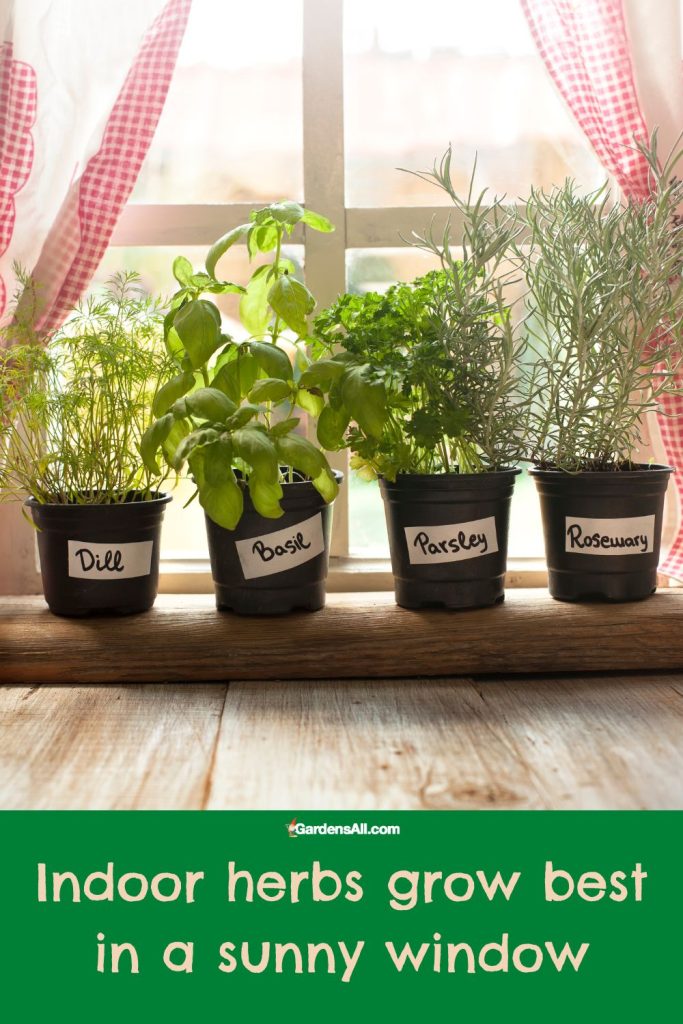
What Herbs Can Grow Outside in Winter?
The following eight herbs can all grow or survive outdoors in winter, though growth will become mostly dormant after repeated temperatures below freezing.
The herbs you can grow outside in the winter largely depend on your location and USDA zone. If, for example, you live in zone 8, then you can likely successfully grow chives, French tarragon, mint, lavender, parsley, rosemary, sage, and thyme.
These plants may stagnate over winter, but they will survive it.
- Winter Gardening: Plants, Flowers, Winterizing, and More
- What Vegetables to Grow in Winter?
- Flowers That Bloom in Winter
Sunlight vs. Grow Light Hours
Since sunlight has a broader spectrum of light as compared to artificial light, it has a more holistic and complex benefit to plants, beyond the mere hours of light. And that’s just of the measurable spectrum known to date.
There is an energy in sunlight that cannot be replicated in artificial lighting. In the ancient Indian language of Sanskrit, it’s called “prana’, which translates as lifeforce. We can feel it too. Step out into a sunlit day and turn your face, eyes closed, to the sun. Step up and face a grow light….? Not so much.
That said, a grow light for growing herbs indoors is like vitamins: not as beneficial as getting the nutrients from the food we eat, but helpful as a supplement.
Grow lights are like supplements for indoor plants… just enough to see them through to spring and summer sunlight.
I’m LeAura Alderson, a garden, herb and plant enthusiast with a passion for discovering the many edible and medicinal benefits of the plants all around us, including the weeds! I’m a writer, editor and media publisher for our family of websites.
While I was certified in fitness and life coaching, I am NOT a health practitioner. However, I’m a lifelong health enthusiast, with a keen interest in healthy, organic foods and making home remedies and the content we share is from our own experience and usage as well as that extracted from scientific research so that you can explore further on your own.
Always seek the advice and guidance of your health practitioners first and foremost.
As a family we’re steadily expanding our gardening, experimentation and knowledge around all things gardening, edible landscaping, fresh organic foods and self sustainability with farming in our future. I also own and manage iCreateDaily.com, a site all about transformation through creation, and the power of positivity, optimism and mindset.
References

